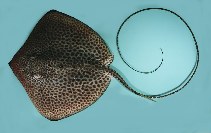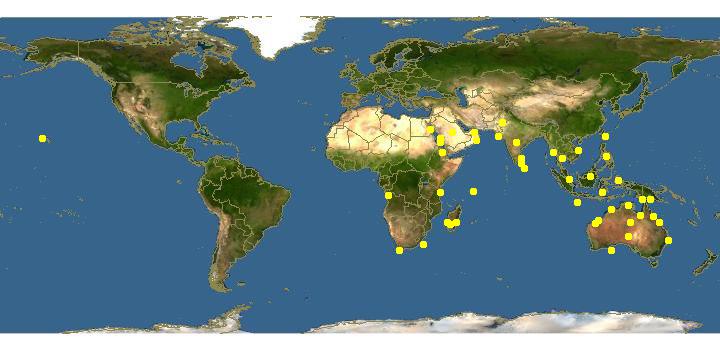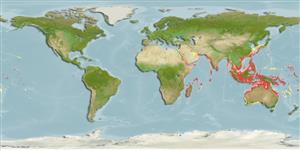http://www.fishbase.org/Summary/speciesSummary.php?genusname=Himantura&speciesname=uarnak ---> http://52.67.158.155/Summary/speciesSummary.php?genusname=Himantura&speciesname=uarnak
http://52.67.158.155/Summary/speciesSummary.php?genusname=Himantura&speciesname=uarnak ---> https://fishbase.net.br/Summary/speciesSummary.php?genusname=Himantura&speciesname=uarnak
https://fishbase.net.br/Summary/speciesSummary.php?genusname=Himantura&speciesname=uarnak ---> https://fishbase.net.br/summary/Himantura-uarnak.html
Himantura uarnak, Honeycomb stingray : fisheries, gamefish, aquarium

You can
sponsor
this page
Common name (e.g. trout)
Genus + Species (e.g. Gadus morhua)
-

-
About this page
-
Languages
-
User feedbacks
-
Citation
-
Uploads
-
Related species
-


 Honeycomb stingray
Add your observation in
Fish Watcher
Upload your
photos
and
videos
Honeycomb stingray
Add your observation in
Fish Watcher
Upload your
photos
and
videos
Pictures
|
Videos |
Stamps, Coins Misc.
|
Google image
 Himantura uarnak
Himantura uarnak
Picture by
Randall, J.E.
Elasmobranchii (sharks and rays) >
Myliobatiformes
(Stingrays) >
Dasyatidae
(Stingrays) > Urogymninae
Etymology:
Himantura:
Greek, iman, imantos = thong, strap + Greek, oura = tail (Ref.
45335
)
.
More on author:
Gmelin
.
Environment: milieu / climate zone / depth range / distribution range
Ecology
Marine; brackish; reef-associated; amphidromous (Ref.
51243
); depth range 20 - 50 m (Ref.
28016
). Subtropical; 23°C - 26°C (Ref.
12468
); 38°N - 37°S, 34°E - 149°W
Indo-Pacific: Persian Gulf (Ref.80050); Red Sea (and eastern Mediterranean via Suez Canal) to southern Africa and French Polynesia, north to Taiwan, south to Australia. Also in the Arafura Sea (Ref.
9819
). Collected from the estuary of the River Ganges (Ref.
33178
). This name has been used for a number of similar spotted species (Ref.
6871
). Probably a species complex (Ref.
35766
). Its identity has been confused in many publications and Micronesian specimens should be re-examined (Ref.
37816
).
Length at first maturity / Size / Weight / Age
Maturity: L
m
83.0
, range 82 - 84 cm
Max length : 200 cm WD male/unsexed; (Ref.
3263
); common length : 45.0 cm TL male/unsexed; (Ref.
5450
); max. published weight: 150.0 kg (Ref.
124786
)
Dorsal
spines
(total): 0;
Dorsal
soft rays
(total): 0;
Anal
spines
: 0;
Anal
soft rays
: 0. Huge stingray with conspicuous dark spots on a light brown disc; spots well-spaced in young but crowded to form reticulated pattern in adult; white ventrally; tail marked with bands of black and white; snout sharply pointed; disc with narrowly rounded outer corners, and tail long, slender and nearly three times body length when intact, with no caudal finfolds; disc without thorns but with band of flat denticles along midback (in adults); usually 1 medium-sized sting on tail (Ref.
5578
).
Common off sandy beaches and in shallow estuaries and lagoons; also found in sandy areas of coral reefs (Ref.
9710
). Also offshore down to 50 m depth (Ref.
5578
). May enter fresh water (Ref.
5578
). Feeds on small fishes, bivalves, crabs, shrimps, worms (Ref.
3263
) and jellyfishes (Ref.
37816
). Ovoviviparous (Ref.
50449
). Common catch of the demersal tangle net, bottom trawl, longline and beach seine fisheries (Ref.58048). Popular angling fish (Ref.
3263
). Not esteemed as a food fish (Ref.
3263
). Used in Chinese medicine (Ref.
12166
). Tail is used as It is parasitised by the monogeneans
Dendromonocotyle colorni
and
Dendromonocotyle ukuthena
on the dorsal skin surface (Ref.
124058
).
Exhibit ovoviparity (aplacental viviparity), with embryos feeding initially on yolk, then receiving additional nourishment from the mother by indirect absorption of uterine fluid enriched with mucus, fat or protein through specialised structures (Ref.
50449
). Distinct pairing with embrace (Ref.
205
). Distinct pairing with embrace (Ref.
205
). Bears 3 to 5 young in the summer (Ref.
5578
). Size at birth about 21 (Ref.58048) - 28 cm WD (Ref.
6871
).
Fricke, R.
, 1999. Fishes of the Mascarene Islands (Réunion, Mauritius, Rodriguez): an annotated checklist, with descriptions of new species. Koeltz Scientific Books, Koenigstein, Theses Zoologicae, Vol. 31:759 p. (Ref.
33390
)
IUCN Red List Status (Ref.
130435
)
Endangered (EN)
(A2d); Date assessed:
27 November 2020
CITES
Not Evaluated
Not Evaluated
Threat to humans
Venomous (Ref.
27550
)
Human uses
Fisheries: commercial; gamefish: yes; aquarium: commercial
FAO - Publication:
search
|
FishSource
|
More information
Countries
FAO areas
Ecosystems
Occurrences
Introductions
Stocks
Ecology
Diet
Food items
Food consumption
Ration
Common names
Synonyms
Metabolism
Predators
Ecotoxicology
Reproduction
Maturity
Spawning
Spawning aggregation
Fecundity
Eggs
Egg development
Age/Size
Growth
Length-weight
Length-length
Length-frequencies
Morphometrics
Morphology
Larvae
Larval dynamics
Recruitment
Abundance
BRUVS
References
Aquaculture
Aquaculture profile
Strains
Genetics
Electrophoreses
Heritability
Diseases
Processing
Nutrients
Mass conversion
Collaborators
Pictures
Stamps, Coins Misc.
Sounds
Ciguatera
Speed
Swim. type
Gill area
Otoliths
Brains
Vision
Tools
Bio-Quiz
|
E-book
|
Field guide
|
Identification keys
|
Length-frequency wizard
|
Life-history tool
|
Point map
|
Classification Tree
|
Catch-MSY
|
Special reports
Check for Aquarium maintenance
|
Check for Species Fact Sheets
|
Check for Aquaculture Fact Sheets
Download XML
Summary page
|
Point data
|
Common names
|
Photos
Internet sources
AFORO (otoliths) |
Alien/Invasive Species database
|
Aquatic Commons
|
BHL
|
Cloffa
|
BOLDSystems
|
Websites from users
|
Check FishWatcher
|
CISTI
|
Catalog of Fishes
:
genus
,
species
|
DiscoverLife
|
ECOTOX
| FAO - Publication:
search
|
Faunafri
|
Fishipedia
|
Fishtrace
| GenBank:
genome
,
nucleotide
|
GloBI
|
Google Books
|
Google Scholar
|
Google
| IGFA World Record |
MitoFish
|
National databases
|
Otolith Atlas of Taiwan Fishes
|
Public aquariums
|
PubMed
|
Reef Life Survey
|
Socotra Atlas
|
Tree of Life
| Wikipedia:
Go
,
Search
| World Records Freshwater Fishing |
Zoological Record
Estimates based on models
Preferred temperature (Ref.
123201
): 24.2 - 28.6, mean 27.8 °C (based on 334 cells).
Phylogenetic diversity index (Ref.
82804
): PD
50
= 0.5000 [Uniqueness, from 0.5 = low to 2.0 = high].
Bayesian length-weight: a=0.01698 (0.00840 - 0.03434), b=3.17 (2.98 - 3.36), in cm total length, based on LWR estimates for this species & (Sub)family-body (Ref.
93245
).
Trophic level (Ref.
69278
): 3.6 ±0.6 se; based on diet studies.
Resilience (Ref.
120179
): Very Low, minimum population doubling time more than 14 years (Fec=3-5).
Fishing Vulnerability (Ref.
59153
): Very high vulnerability (90 of 100).
Price category (Ref.
80766
):
Low
.
Nutrients (Ref.
124155
): Calcium = 3.06 [0.35, 48.42] mg/100g; Iron = 0.343 [0.028, 3.859] mg/100g; Protein = 22.3 [19.6, 25.0] %; Omega3 = 0.113 [0.036, 0.335] g/100g; Selenium = 15.7 [2.7, 86.6] μg/100g; VitaminA = 10.9 [0.9, 124.7] μg/100g; Zinc = 0.504 [0.035, 5.570] mg/100g (wet weight);
Back to Search
Random Species
Back to Top
Accessed through:
Not available
FishBase mirror site :
Laguna, Philippines
Page last modified by :
mrius-barile
|






